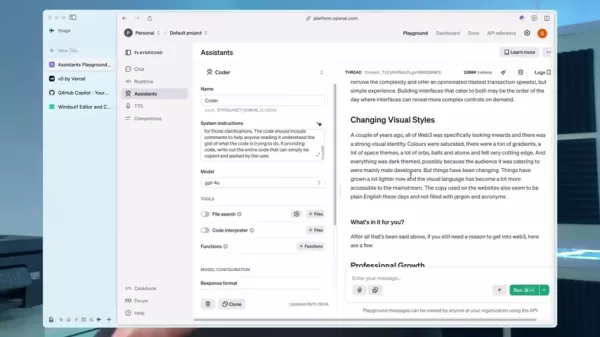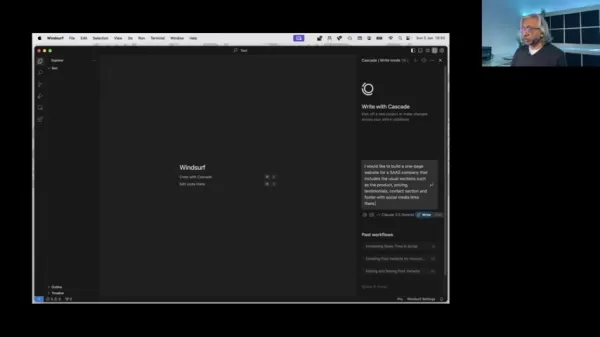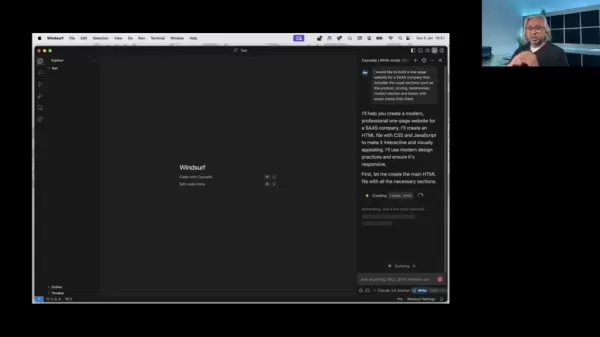AI in UX Design: Windsurf, GitHub Copilot & the Future of Roles
The world of UX design is undergoing a profound transformation, thanks to the integration of artificial intelligence. As a UX designer, I've always been on the lookout for ways to make our work smoother and the user experience richer. The advent of AI-powered tools like Windsurf and GitHub Copilot has opened up a whole new world of possibilities, but it also brings its own set of challenges. It's a thrilling time to be in the field, as we navigate the changing landscape and consider what it means for the roles of designers and developers moving forward.
The AI Revolution in UX Design: A Paradigm Shift
The Loss in Translation: Bridging the Design-to-Code Gap
One of the most frustrating parts of my job as a UX designer is seeing a beautiful design get lost in translation when it's turned into code. It's like watching your masterpiece slowly lose its essence. Traditionally, designers and developers have worked in their own bubbles, leading to misunderstandings and compromises that can water down the user experience. But AI is changing this game entirely.
AI tools are stepping in to automate the conversion of designs into code, promising a future where the transition is seamless and true to the original vision. This means we can focus more on the big picture—enhancing user experiences and making strategic decisions—rather than getting caught up in the nitty-gritty of coding.
V0 by Vercel: A Glimpse into the Future
I recently got my hands on V0 by Vercel, and it's a game-changer for the design-to-code process. Here's a snapshot of what it can do:

Using V0 was a bit of a learning curve at first; I had to be very specific about what I wanted. It felt like guiding a friend through a recipe, but the end result was worth it. I ended up with a set of pre-built files that were a breeze for a developer to work with. This experience, coupled with my experiments with Windsurf and GitHub Copilot, has really made me rethink the roles of designers and developers. We're moving into a world where these roles might not be as distinct as they once were.

Windsurf and GitHub Copilot: Questioning Roles
My journey with these AI tools has led me to question the very essence of what it means to be a designer or a developer. The lines are blurring, and I find myself adapting my approach to design. It's an exciting, albeit daunting, prospect to consider how these roles might evolve or even merge in the future.
AI's Impact on Design and Development
Impact #1: Software Applications Go Bye-Bye
Imagine a world where you can describe what you need, and AI whips up the code for it on the spot. It's a future where we don't need to rely on clunky software packages anymore. Instead, we can create custom solutions tailored to our exact needs. It's a bit mind-blowing to think about, but it's where we're headed.

Impact #2: Skills Will Need to Change
With AI taking care of the technical heavy lifting, the skills that matter are shifting. It's no longer just about mastering code; it's about being a strategic thinker, a creative problem-solver, and a planner. The future belongs to the generalists who can navigate this new landscape with agility.
Impact #3: Companies of the Future are Smaller
The rise of AI means that smaller teams can achieve what used to require large organizations. I came across this tweet that sums it up perfectly:

It's a game-changer for economies, leveling the playing field for solo founders and small startups.
Impact #4: Economies Aligned Toward Startups Will Flourish
Countries that make it easy to start a business are set to thrive in this new era. With AI unlocking so much productivity, we're going to see a surge in entrepreneurial activity.
Impact #5: Three Dimensional Humans
I've always believed that humans are meant to be multifaceted, not pigeonholed into one skill set. AI is helping us move away from specialized roles towards a more holistic approach to work. It's a return to our natural state of being.
Impact #6: The Users of Design Tools Will Change
Tools like Photoshop used to be the domain of specialists, but now, with platforms like Krea.ai, anyone can generate and edit images. It's democratizing design, making it accessible to marketers and other non-specialists.
Impact #7: Economies of Scale Have Suddenly Changed
The cost of building software is dropping, thanks to AI. This means more individuals can create and profit from their ideas, leading to a more empowered society.
Impact #8: Physical Challenges Can be Addressed
AI is also a game-changer for accessibility. It can create interfaces tailored to individual needs, helping people with physical disabilities overcome digital barriers.
Impact #9: Get Rid of the Digital Chasm
Design tools are no longer one-size-fits-all. With AI, we can create solutions that are inclusive and accessible, bridging the digital divide for people with disabilities.
How to Use Windsurf and GitHub Copilot
Quick Description
Let's dive into how you can start using these tools. Here's a simple example:

With just a bit of planning, you can begin to see the potential.
Quick Description of What I am Looking For
For instance, I wanted to create a one-page website for a SAAS company, complete with sections for the product, pricing, testimonials, contact, and a footer with social media links. Here's what it might look like:

I kept my description broad, focusing on the essentials and leaving room for customization through CSS variables. Notice that I didn't specify anything about responsiveness or frameworks, letting AI handle those details.
Windsurf: Unveiling the Pros and Cons
Pros
- Simplifies code generation
- Speeds up prototyping
- Fosters design-development collaboration
- Reduces development costs
Cons
- Potentially steep learning curve
- Dependency on AI algorithms
- Limited customization options
- May not fully capture the nuances of human design
FAQ
What is V0 by Vercel?
V0 is a tool from Vercel that automates the translation of design into code. It's a boon for UX designers, allowing us to prototype and implement designs more efficiently. It uses AI to interpret design elements and generate corresponding code, easing the burden of manual coding and bridging the gap between design and development.
How do Windsurf and GitHub Copilot impact designers and developers?
These AI tools are reshaping the roles of designers and developers. By automating the technical aspects, they free us up to focus on strategy, creativity, and problem-solving. It's a shift that requires us to broaden our skill sets and work more collaboratively, blurring the lines between our traditional roles.
What are the implications of these AI tools?
The implications are far-reaching. AI tools like Windsurf and GitHub Copilot streamline workflows, speed up time to market, cut development costs, and sharpen the focus on user experience. They also shift economies towards startups, opening up more opportunities for smaller companies and unlocking innovation for professionals at all levels.
Related Questions
What are the key concerns surrounding the use of AI in UX design?
As AI becomes more integral to UX design, we need to keep an eye on several key concerns. Maintaining human oversight and creativity is crucial, as is addressing ethical considerations, data privacy, and potential biases in AI algorithms. Ensuring accessibility and inclusivity in AI-driven designs is also vital to prevent widening existing inequalities. Lastly, we must upskill and reskill to leverage AI effectively while retaining our core competencies.
How can UX designers prepare for the future of AI in design?
To thrive in this AI-driven era, UX designers need to embrace continuous learning and adapt their skills. Here are some key areas to focus on:
- Developing AI literacy: Understanding AI's capabilities and limitations is essential for integrating these tools into our workflows.
- Honing soft skills: As AI handles more technical tasks, skills like creativity, communication, empathy, and critical thinking become even more important.
- Becoming a strategic thinker: Focus on high-level strategic decision-making, defining the 'what' and 'why' of design while AI handles the 'how'.
- Mastering human-centered design principles: Even with AI's increasing role, user-centered design principles remain crucial. Emphasize user research, usability testing, and iterative design to ensure AI-driven designs meet user needs effectively.
Related article
 GitHub and Microsoft Join Anthropic’s AI Data Connection Standard
GitHub and its parent company, Microsoft, have joined the steering committee for Anthropic’s MCP, a standard for linking AI models to data systems.Revealed at Microsoft’s Build 2025 conference on Mond
GitHub and Microsoft Join Anthropic’s AI Data Connection Standard
GitHub and its parent company, Microsoft, have joined the steering committee for Anthropic’s MCP, a standard for linking AI models to data systems.Revealed at Microsoft’s Build 2025 conference on Mond
 ChatGPT Enhances Code Query Capabilities with New GitHub Connector
OpenAI Expands ChatGPT's Deep Research Capabilities with GitHub IntegrationOpenAI has taken a significant step forward in enhancing its AI-powered "deep research" feature by integr
ChatGPT Enhances Code Query Capabilities with New GitHub Connector
OpenAI Expands ChatGPT's Deep Research Capabilities with GitHub IntegrationOpenAI has taken a significant step forward in enhancing its AI-powered "deep research" feature by integr
 Former DeepSeeker and collaborators release new method for training reliable AI agents: RAGEN
The Year of AI Agents: A Closer Look at 2025's Expectations and Realities2025 was heralded by many experts as the year when AI agents—specialized AI systems powered by advanced large language and multimodal models from companies like OpenAI, Anthropic, Google, and DeepSeek—would finally take center
Comments (12)
0/200
Former DeepSeeker and collaborators release new method for training reliable AI agents: RAGEN
The Year of AI Agents: A Closer Look at 2025's Expectations and Realities2025 was heralded by many experts as the year when AI agents—specialized AI systems powered by advanced large language and multimodal models from companies like OpenAI, Anthropic, Google, and DeepSeek—would finally take center
Comments (12)
0/200
![MatthewScott]() MatthewScott
MatthewScott
 August 11, 2025 at 3:00:59 PM EDT
August 11, 2025 at 3:00:59 PM EDT
¡Qué locura cómo la IA está cambiando el diseño UX! Herramientas como Windsurf y Copilot parecen súper útiles, pero ¿no crees que podrían quitarle un poco de alma al proceso creativo? 🧐


 0
0
![FredGreen]() FredGreen
FredGreen
 August 5, 2025 at 7:00:59 AM EDT
August 5, 2025 at 7:00:59 AM EDT
AI in UX design sounds like a game-changer! Windsurf and Copilot could really speed up workflows, but I wonder if they’ll make designers feel like they’re just babysitting algorithms. 🤔


 0
0
![NicholasClark]() NicholasClark
NicholasClark
 April 23, 2025 at 7:39:46 PM EDT
April 23, 2025 at 7:39:46 PM EDT
UXデザインにおけるAIは本当に興味深いです!WindsurfやGitHub Copilotのようなツールはゲームチェンジャーです。ただ、伝統的なUXの役割にどのように影響するかが少し心配です。それでも、未来はエキサイティングに見えます!🚀


 0
0
![DouglasMitchell]() DouglasMitchell
DouglasMitchell
 April 23, 2025 at 2:47:18 PM EDT
April 23, 2025 at 2:47:18 PM EDT
¡La IA en el diseño de UX es fascinante! Herramientas como Windsurf y GitHub Copilot son revolucionarias. Pero me preocupa un poco cómo podrían afectar los roles tradicionales de UX. Aún así, el futuro parece emocionante! 🚀


 0
0
![ThomasYoung]() ThomasYoung
ThomasYoung
 April 21, 2025 at 3:03:53 PM EDT
April 21, 2025 at 3:03:53 PM EDT
A IA no design de UX é fascinante! Ferramentas como Windsurf e GitHub Copilot são transformadoras. Mas estou um pouco preocupado com como elas podem afetar os papéis tradicionais de UX. Ainda assim, o futuro parece emocionante! 🚀


 0
0
![JeffreyThomas]() JeffreyThomas
JeffreyThomas
 April 20, 2025 at 1:45:44 PM EDT
April 20, 2025 at 1:45:44 PM EDT
Windsurf y GitHub Copilot han cambiado totalmente mi flujo de trabajo como diseñador de UX. ¡Es como tener un asistente inteligente que me ayuda a optimizar diseños y enfocarme en la creatividad! A veces las sugerencias están un poco fuera, pero en general, es de gran ayuda. ¡Vale la pena probarlo! 🚀


 0
0
The world of UX design is undergoing a profound transformation, thanks to the integration of artificial intelligence. As a UX designer, I've always been on the lookout for ways to make our work smoother and the user experience richer. The advent of AI-powered tools like Windsurf and GitHub Copilot has opened up a whole new world of possibilities, but it also brings its own set of challenges. It's a thrilling time to be in the field, as we navigate the changing landscape and consider what it means for the roles of designers and developers moving forward.
The AI Revolution in UX Design: A Paradigm Shift
The Loss in Translation: Bridging the Design-to-Code Gap
One of the most frustrating parts of my job as a UX designer is seeing a beautiful design get lost in translation when it's turned into code. It's like watching your masterpiece slowly lose its essence. Traditionally, designers and developers have worked in their own bubbles, leading to misunderstandings and compromises that can water down the user experience. But AI is changing this game entirely.
AI tools are stepping in to automate the conversion of designs into code, promising a future where the transition is seamless and true to the original vision. This means we can focus more on the big picture—enhancing user experiences and making strategic decisions—rather than getting caught up in the nitty-gritty of coding.
V0 by Vercel: A Glimpse into the Future
I recently got my hands on V0 by Vercel, and it's a game-changer for the design-to-code process. Here's a snapshot of what it can do:

Using V0 was a bit of a learning curve at first; I had to be very specific about what I wanted. It felt like guiding a friend through a recipe, but the end result was worth it. I ended up with a set of pre-built files that were a breeze for a developer to work with. This experience, coupled with my experiments with Windsurf and GitHub Copilot, has really made me rethink the roles of designers and developers. We're moving into a world where these roles might not be as distinct as they once were.

Windsurf and GitHub Copilot: Questioning Roles
My journey with these AI tools has led me to question the very essence of what it means to be a designer or a developer. The lines are blurring, and I find myself adapting my approach to design. It's an exciting, albeit daunting, prospect to consider how these roles might evolve or even merge in the future.
AI's Impact on Design and Development
Impact #1: Software Applications Go Bye-Bye
Imagine a world where you can describe what you need, and AI whips up the code for it on the spot. It's a future where we don't need to rely on clunky software packages anymore. Instead, we can create custom solutions tailored to our exact needs. It's a bit mind-blowing to think about, but it's where we're headed.

Impact #2: Skills Will Need to Change
With AI taking care of the technical heavy lifting, the skills that matter are shifting. It's no longer just about mastering code; it's about being a strategic thinker, a creative problem-solver, and a planner. The future belongs to the generalists who can navigate this new landscape with agility.
Impact #3: Companies of the Future are Smaller
The rise of AI means that smaller teams can achieve what used to require large organizations. I came across this tweet that sums it up perfectly:

It's a game-changer for economies, leveling the playing field for solo founders and small startups.
Impact #4: Economies Aligned Toward Startups Will Flourish
Countries that make it easy to start a business are set to thrive in this new era. With AI unlocking so much productivity, we're going to see a surge in entrepreneurial activity.
Impact #5: Three Dimensional Humans
I've always believed that humans are meant to be multifaceted, not pigeonholed into one skill set. AI is helping us move away from specialized roles towards a more holistic approach to work. It's a return to our natural state of being.
Impact #6: The Users of Design Tools Will Change
Tools like Photoshop used to be the domain of specialists, but now, with platforms like Krea.ai, anyone can generate and edit images. It's democratizing design, making it accessible to marketers and other non-specialists.
Impact #7: Economies of Scale Have Suddenly Changed
The cost of building software is dropping, thanks to AI. This means more individuals can create and profit from their ideas, leading to a more empowered society.
Impact #8: Physical Challenges Can be Addressed
AI is also a game-changer for accessibility. It can create interfaces tailored to individual needs, helping people with physical disabilities overcome digital barriers.
Impact #9: Get Rid of the Digital Chasm
Design tools are no longer one-size-fits-all. With AI, we can create solutions that are inclusive and accessible, bridging the digital divide for people with disabilities.
How to Use Windsurf and GitHub Copilot
Quick Description
Let's dive into how you can start using these tools. Here's a simple example:

With just a bit of planning, you can begin to see the potential.
Quick Description of What I am Looking For
For instance, I wanted to create a one-page website for a SAAS company, complete with sections for the product, pricing, testimonials, contact, and a footer with social media links. Here's what it might look like:

I kept my description broad, focusing on the essentials and leaving room for customization through CSS variables. Notice that I didn't specify anything about responsiveness or frameworks, letting AI handle those details.
Windsurf: Unveiling the Pros and Cons
Pros
- Simplifies code generation
- Speeds up prototyping
- Fosters design-development collaboration
- Reduces development costs
Cons
- Potentially steep learning curve
- Dependency on AI algorithms
- Limited customization options
- May not fully capture the nuances of human design
FAQ
What is V0 by Vercel?
V0 is a tool from Vercel that automates the translation of design into code. It's a boon for UX designers, allowing us to prototype and implement designs more efficiently. It uses AI to interpret design elements and generate corresponding code, easing the burden of manual coding and bridging the gap between design and development.
How do Windsurf and GitHub Copilot impact designers and developers?
These AI tools are reshaping the roles of designers and developers. By automating the technical aspects, they free us up to focus on strategy, creativity, and problem-solving. It's a shift that requires us to broaden our skill sets and work more collaboratively, blurring the lines between our traditional roles.
What are the implications of these AI tools?
The implications are far-reaching. AI tools like Windsurf and GitHub Copilot streamline workflows, speed up time to market, cut development costs, and sharpen the focus on user experience. They also shift economies towards startups, opening up more opportunities for smaller companies and unlocking innovation for professionals at all levels.
Related Questions
What are the key concerns surrounding the use of AI in UX design?
As AI becomes more integral to UX design, we need to keep an eye on several key concerns. Maintaining human oversight and creativity is crucial, as is addressing ethical considerations, data privacy, and potential biases in AI algorithms. Ensuring accessibility and inclusivity in AI-driven designs is also vital to prevent widening existing inequalities. Lastly, we must upskill and reskill to leverage AI effectively while retaining our core competencies.
How can UX designers prepare for the future of AI in design?
To thrive in this AI-driven era, UX designers need to embrace continuous learning and adapt their skills. Here are some key areas to focus on:
- Developing AI literacy: Understanding AI's capabilities and limitations is essential for integrating these tools into our workflows.
- Honing soft skills: As AI handles more technical tasks, skills like creativity, communication, empathy, and critical thinking become even more important.
- Becoming a strategic thinker: Focus on high-level strategic decision-making, defining the 'what' and 'why' of design while AI handles the 'how'.
- Mastering human-centered design principles: Even with AI's increasing role, user-centered design principles remain crucial. Emphasize user research, usability testing, and iterative design to ensure AI-driven designs meet user needs effectively.
 GitHub and Microsoft Join Anthropic’s AI Data Connection Standard
GitHub and its parent company, Microsoft, have joined the steering committee for Anthropic’s MCP, a standard for linking AI models to data systems.Revealed at Microsoft’s Build 2025 conference on Mond
GitHub and Microsoft Join Anthropic’s AI Data Connection Standard
GitHub and its parent company, Microsoft, have joined the steering committee for Anthropic’s MCP, a standard for linking AI models to data systems.Revealed at Microsoft’s Build 2025 conference on Mond
 ChatGPT Enhances Code Query Capabilities with New GitHub Connector
OpenAI Expands ChatGPT's Deep Research Capabilities with GitHub IntegrationOpenAI has taken a significant step forward in enhancing its AI-powered "deep research" feature by integr
ChatGPT Enhances Code Query Capabilities with New GitHub Connector
OpenAI Expands ChatGPT's Deep Research Capabilities with GitHub IntegrationOpenAI has taken a significant step forward in enhancing its AI-powered "deep research" feature by integr
 Former DeepSeeker and collaborators release new method for training reliable AI agents: RAGEN
The Year of AI Agents: A Closer Look at 2025's Expectations and Realities2025 was heralded by many experts as the year when AI agents—specialized AI systems powered by advanced large language and multimodal models from companies like OpenAI, Anthropic, Google, and DeepSeek—would finally take center
Former DeepSeeker and collaborators release new method for training reliable AI agents: RAGEN
The Year of AI Agents: A Closer Look at 2025's Expectations and Realities2025 was heralded by many experts as the year when AI agents—specialized AI systems powered by advanced large language and multimodal models from companies like OpenAI, Anthropic, Google, and DeepSeek—would finally take center
 August 11, 2025 at 3:00:59 PM EDT
August 11, 2025 at 3:00:59 PM EDT
¡Qué locura cómo la IA está cambiando el diseño UX! Herramientas como Windsurf y Copilot parecen súper útiles, pero ¿no crees que podrían quitarle un poco de alma al proceso creativo? 🧐


 0
0
 August 5, 2025 at 7:00:59 AM EDT
August 5, 2025 at 7:00:59 AM EDT
AI in UX design sounds like a game-changer! Windsurf and Copilot could really speed up workflows, but I wonder if they’ll make designers feel like they’re just babysitting algorithms. 🤔


 0
0
 April 23, 2025 at 7:39:46 PM EDT
April 23, 2025 at 7:39:46 PM EDT
UXデザインにおけるAIは本当に興味深いです!WindsurfやGitHub Copilotのようなツールはゲームチェンジャーです。ただ、伝統的なUXの役割にどのように影響するかが少し心配です。それでも、未来はエキサイティングに見えます!🚀


 0
0
 April 23, 2025 at 2:47:18 PM EDT
April 23, 2025 at 2:47:18 PM EDT
¡La IA en el diseño de UX es fascinante! Herramientas como Windsurf y GitHub Copilot son revolucionarias. Pero me preocupa un poco cómo podrían afectar los roles tradicionales de UX. Aún así, el futuro parece emocionante! 🚀


 0
0
 April 21, 2025 at 3:03:53 PM EDT
April 21, 2025 at 3:03:53 PM EDT
A IA no design de UX é fascinante! Ferramentas como Windsurf e GitHub Copilot são transformadoras. Mas estou um pouco preocupado com como elas podem afetar os papéis tradicionais de UX. Ainda assim, o futuro parece emocionante! 🚀


 0
0
 April 20, 2025 at 1:45:44 PM EDT
April 20, 2025 at 1:45:44 PM EDT
Windsurf y GitHub Copilot han cambiado totalmente mi flujo de trabajo como diseñador de UX. ¡Es como tener un asistente inteligente que me ayuda a optimizar diseños y enfocarme en la creatividad! A veces las sugerencias están un poco fuera, pero en general, es de gran ayuda. ¡Vale la pena probarlo! 🚀


 0
0





























